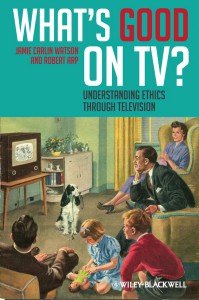What’s Good On TV?: Understanding Ethics Through Television by Jamie Carlin Watson and Robert Arp (Wiley-Blackwell, 2011). 320 pages. ISBN: 978-1405194754 (paperback), £19.99; ISBN: 978-1405194761 (hardback), £55.
 About the Author: Dr Chris Willmott is Senior Lecturer in Biochemistry at the University of Leicester and has a special interest in bioethics teaching. He is the author of the BioethicsBytes blog: bioethicsbytes.wordpress.com, which recommends clips for teaching about bioethics. He has also contributed chapters to two books on Doctor Who and philosophy.
E-mail: cjrw2@le.ac.uk
About the Author: Dr Chris Willmott is Senior Lecturer in Biochemistry at the University of Leicester and has a special interest in bioethics teaching. He is the author of the BioethicsBytes blog: bioethicsbytes.wordpress.com, which recommends clips for teaching about bioethics. He has also contributed chapters to two books on Doctor Who and philosophy.
E-mail: cjrw2@le.ac.uk
I was very excited when I received a flyer from the publisher advertising the release of this new book. As someone who makes regular use of TV and film clips in teaching ethics with bioscience students I was interested to see what fresh insights the authors had provided.
What’s Good on TV? has three principal sections: The nature of moral value, ethical theory and practical ethics (the authors call the sections 'Series', but I will stick with the conventional terminology to avoid confusion with actual series being discussed). Within each section there are several chapters (aka 'Episodes', naming which I will eschew for the same reason given above). Each chapter includes a synopsis of at least one classic ethical text on the theme under discussion, one or two case studies based around a particular TV episode and some study questions.
 Philosophy and popular culture: The early years of the 21st Century have seen significant usage of popular culture, including television programmes, as vehicles for the general public to engage with different aspects of philosophy. Since 2000, Open Court publishers have produced a successful series of Popular Culture and Philosophy books which now runs to nearly 70 titles. Wiley themselves have entered the fray with over 35 books in their Blackwell Philosophy and Pop Culture series. Robert Arp, one of the authors of the present title, has contributed chapters to many of the books in both series, as well as editing South Park and Philosophy: You Know, I Learned Something Today and co-editing Batman and Philosophy: The Dark Knight of the Soul. As these examples demonstrate, such books are targeted at the general reader interested to know how their favourite TV series, film, rock band - or even the Atkins diet - can offer insights into philosophy.
Philosophy and popular culture: The early years of the 21st Century have seen significant usage of popular culture, including television programmes, as vehicles for the general public to engage with different aspects of philosophy. Since 2000, Open Court publishers have produced a successful series of Popular Culture and Philosophy books which now runs to nearly 70 titles. Wiley themselves have entered the fray with over 35 books in their Blackwell Philosophy and Pop Culture series. Robert Arp, one of the authors of the present title, has contributed chapters to many of the books in both series, as well as editing South Park and Philosophy: You Know, I Learned Something Today and co-editing Batman and Philosophy: The Dark Knight of the Soul. As these examples demonstrate, such books are targeted at the general reader interested to know how their favourite TV series, film, rock band - or even the Atkins diet - can offer insights into philosophy.
The first thing to establish, therefore, is that What’s Good on TV? is not one of those books. This is very definitely an ethics textbook rather than an introductory guide for a TV enthusiast wanting to dip her toe into the world of ethics and philosophy. There are three target audiences identified in the Preface: students of popular culture, media, philosophy and similar courses; their instructors; and general readers interested in ethics. The book has received a positive review, from a student perspective, published in the Times Higher Education magazine (http://tinyurl.com/THEstudentreview). What did I make of it from an educator’s viewpoint?
I am in full agreement with the authors’ central premise that popular culture references, such as those delivered via TV series, are more efficient tools than traditional textbook examples for explaining philosophical concepts to contemporary students. To this end, they use television programmes in three distinct ways in this book. As noted above, there is at least one detailed Case Study in each Chapter. Additionally, several programmes are used as illustrations within the main text of the book. Finally, each chapter concludes with a list of other potential TV episodes where similar themes are considered.
So far all sounds very promising. I am, however, left with a number of significant reservations. Firstly, I am not sure how familiar UK readers will be with the programme examples used. In total, there are approximately ninety episodes (or whole series) cited in the book. Of these, however, only five originate from this side of the pond; the classic Monty Python 'argument' sketch, two episodes on The Office (UK), one of Absolutely Fabulous and, somewhat bizarrely, one episode of Foyle’s War – which is recommended twice.
We do, of course, have ready access to lots of American programmes and the most frequently cited series will be known to UK viewers. Nevertheless, there are examples from other series of which this reviewer (a self-confessed TV addict) was aware but had never seen (e.g. Californication, My Name is Earl, Nip/Tuck, Northern Exposure) and yet others of which I’d never heard (e.g. All in the Family, Joan of Arcadia, Maude, Oz, Picket Fences and Touched by an Angel). Perhaps unsurprisingly, given Arp’s previous work, there are five recommendations from South Park. There are a further five for Family Guy and for Law and Order, four for The Simpsons, and three each for Cheers, Scrubs, Sex and the City, The Sopranos and for Star Trek: The Next Generation, including the excellent 'Justice' which is endorsed in three separate places and is, for me, the 'find' for which I am most grateful to the authors.
According to the Television and Radio Index for Learning and Teaching (TRILT) many of these programmes continue to be shown on assorted satellite/cable channels and sometimes even on terrestrial services. Yet even if they can be obtained, I am not convinced that UK students will be sufficiently conversant with the series for the chosen examples to have immediate resonance.
Secondly, I found that the book did not deliver sufficient guidance for educators on the best ways to use the recommended episodes. There are, of course, the case studies, accompanied by some study questions. However, many of the questions relate to general ethical dilemmas or issues raised by the book rather than being about the TV programme per se. We are not really given any impression of the way(s) that the authors themselves are using the episodes in their teaching.
It is clear that some episodes (such as Star Trek: The Next Generation 'Justice) are worth showing to a class in their entirety. It looks like other programmes are being valued only for a short scene. For example, there seems little benefit in watching the whole of Arrested Development 'Charity Drive' merely to see a short exchange between Michael and his mother which illustrates their prejudices. Some indication of how the authors utilise the recommended episodes, perhaps with time-coding of particularly strong clips, would be a valuable addition to any new edition of the book.
I have significant reservations about some of the examples that have been chosen for discussion
Thirdly, I have significant reservations about some of the examples that have been chosen for discussion. The Epilogue notes the authors’ distaste regarding a series Scare Tactics, an extreme example of the prank genre, in which unsuspecting members of the public are set up by their 'friends' in what appears to the participant to be a genuine life-threatening scenario. Nevertheless I did feel that some of the other programmes they recommended are actually inappropriate for use in teaching.
Even if we personally would be comfortable watching certain episodes, in our role as educators I believe we have a duty to be acutely aware of the potential sensibilities of our students, many of whom will come from significantly different cultural backgrounds. The criteria for appropriateness therefore needs to be set higher than if we were simply deciding what to watch in our own home.
As it happens, some of the recommendations here would even breach my own personal boundaries. Despite the fact that I regularly use an episode of South Park ('Kenny Dies') in my ethics teaching, the authors’ description of 'Death camp of tolerance', another episode from that series, and of Family Guy 'PTV', alert me that these are episodes I do not even want to see myself, let alone share with a class.
Finally, I worry that UK educators acting on the recommendation of NetFlix as a source of programmes for use in their teaching will actually be falling foul of the law. Although this service is now becoming established here for domestic use, we do not have the same rules as the USA regarding 'fair use' of copyrighted material. On the other hand, we are blessed instead with the agreements under Section 35 of the Copyright, Designs and Patents Act 1988, that materials for educational purposes can be made available in institutions holding an appropriate Educational Recording Agency licence (www.era.org.uk).
In summary, I did enjoy reading What’s Good on TV? and it has alerted me to some episodes which are likely to make their way into my teaching. I found the book to be at its best when introducing ethical theory and practical ethics. Judged on these grounds, however, it is competing in a relatively crowded market place. Regrettably, it is in regard to its apparent unique selling point – the discussion of TV as a medium to illustrate ethics education – that I found the book failed to deliver.
Dr Chris J R Willmott